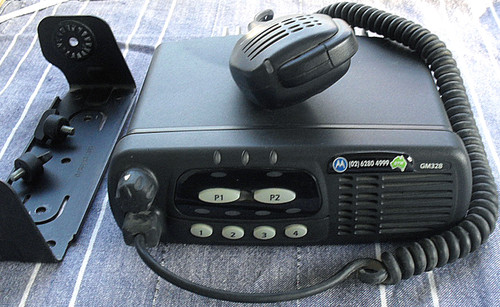This portable transceiver is supplied "deprogrammed" and it will be necessary for the new owner to undertake programming to the required frequencies
Kenwood UHF portable transceiver
Model: TK380 E2
Design frequency range: 470Mhz - 520Mhz
Conventional and Trunking (LTR) capability
Analog voice transmissions although also digital capable with short/long text messaging using external equipment (optional equipment which is not supplied)
Capable of up to 250 Groups / 250 Channels
Low & High power TX output (maximum 4W RF)
Narrow, Semi-wideband & Wideband channel spacing (12.5Khz/20Khz/25Khz)
Many programmable features such as those you would expect (RX/TX pairs, channel spacing etc) and many others such as PTT ID, Selcal ID, Kill, Stun, QST etc
Full details are available in the manuals I am offering with this equipment.
I am including all items shown in the photographs (antenna, battery, metal battery belt clip & original Kenwood battery charger) plus 3x Kenwood manuals (Operating Instructions, Service Manual for the TK380 E series and another service manual specific to the E2 release - all are clean/clear reproductions) plus the KPG-60D programming software.
NOT INCLUDED:
KMC-25 External Speaker/Microphone
Universal Connector or the programming cable (KPG-36)
The transceiver has an internal speaker and microphone, these are fine for "normal" use.
Programming cables are readily available online, not difficult to find at all. These may be offered in standard serial port or USB versions.
Basic Specifications:
Ruggedised construction for harsh conditions, diecast frame (which in many ways looks just like a Motorola)
Metal belt clip
Hi and Lo output RF power output
Alphanumeric LCD display with backlight - this displays status messages and alpha names attached to each programmed channel/group
Provides up to 250 channels
Monitor channel on-off (kills the squelch)
Front panel buttons are programmable
Password lock option
Measures 153 mm(H) x 57mm(W) x 50 mm(D)
Weighs 500g (with antenna and battery pack fitted)
COSMETIC CONDITION:
Very clean with very little signs of use
LCD screen is clean and undamaged
No missing corners, deep scratches or other marks
TESTING:
History of this equipment: Ex commercial use (NSW Government Transport) and obtained due to system upgrades by the user.
Transmission is currently disabled (push the PTT and you will just get "beep beep beep" with no RF output
Using the channel monitor function, I can hear "channel white noise" but no traffic
LCD displays the "old" channel designations e.g RTA, NORTH, SOUTH etc - these channel designations are entered when externally programming with the KPG-60D software
This transceiver is fully operational BUT it is supplied with the original TX programming disabled (to prevent access to commercial services)
I went into one of the "test modes" (held down "A" when turning on) and confirmed transmit output at various frequencies plus voice modulation - clean and clear.
The Service Manual (supplied) details how to access the Test Modes in full detail, if somewhat complicated (as there are many options)
I could only confirm TX output with some test equipment I have available because my Anritsu RF signal generator which I would have used to check the RX channels has been sold but I am 100% confident that the receive side of things is working fine also.
I had both low and high power RF output on these frequencies (built in test mode presets)
491.1062Mhz
470.1062Mhz
511.9125Mhz
491.0062Mhz
491.2062Mhz
491.4062Mhz
468.0062Mhz
470.0062Mhz
I also checked with voice modulation, all good.
Also sent some preset DTMF tones, just for fun - sounds "cool"
Transceiver channel programming is via the KPG-60D software, designed for Win 95/98 but I have it setup on a Win 7 machine and it works just fine - comms was using the PC serial port direct, not USB.
Originally this software was on floppys but I will be supplying it on a CD along with the various manuals.
Being designed for the 470-520Mhz frequency range, this transceiver is suitable for programming to suit UHF CB channels or special purpose commercial channels.
Although out of range for 70cm use (Amateur Radio frequency allocations) I have been told that this equipment CAN be pushed out of design frequency range although it should be expected to alter the specifications such as RF power output, receive sensitivity etc
I guess the key with this equipment is experimentation - hook up the programming cable, fire up the software and see what you can make the transceiver do. Even without the external programming, there is a lot of interesting features accessible via the built in test modes.











